SITXINV001 Receive and Store Stock: Complete Solution for Worksheets
VerifiedAdded on 2023/06/18
|15
|3471
|169
Homework Assignment
AI Summary
This assignment provides detailed solutions to the SITXINV001 Receive and Store Stock worksheets. It covers various aspects of stock management, including checking incoming stock for discrepancies, identifying damage indicators, recording stock details, and understanding the differences between order forms, delivery notes, and invoices. The solutions also address how to handle discrepancies, deficiencies, and quality problems, as well as communication strategies for reporting these issues. Furthermore, the assignment discusses safe manual handling techniques, proper storage areas for different goods, and guidelines for labeling stock. It also covers actions to take when excess stock is discovered and provides insights into using a forklift safely. This document is a comprehensive guide for understanding and mastering stock management principles, with Desklib offering additional resources for students.
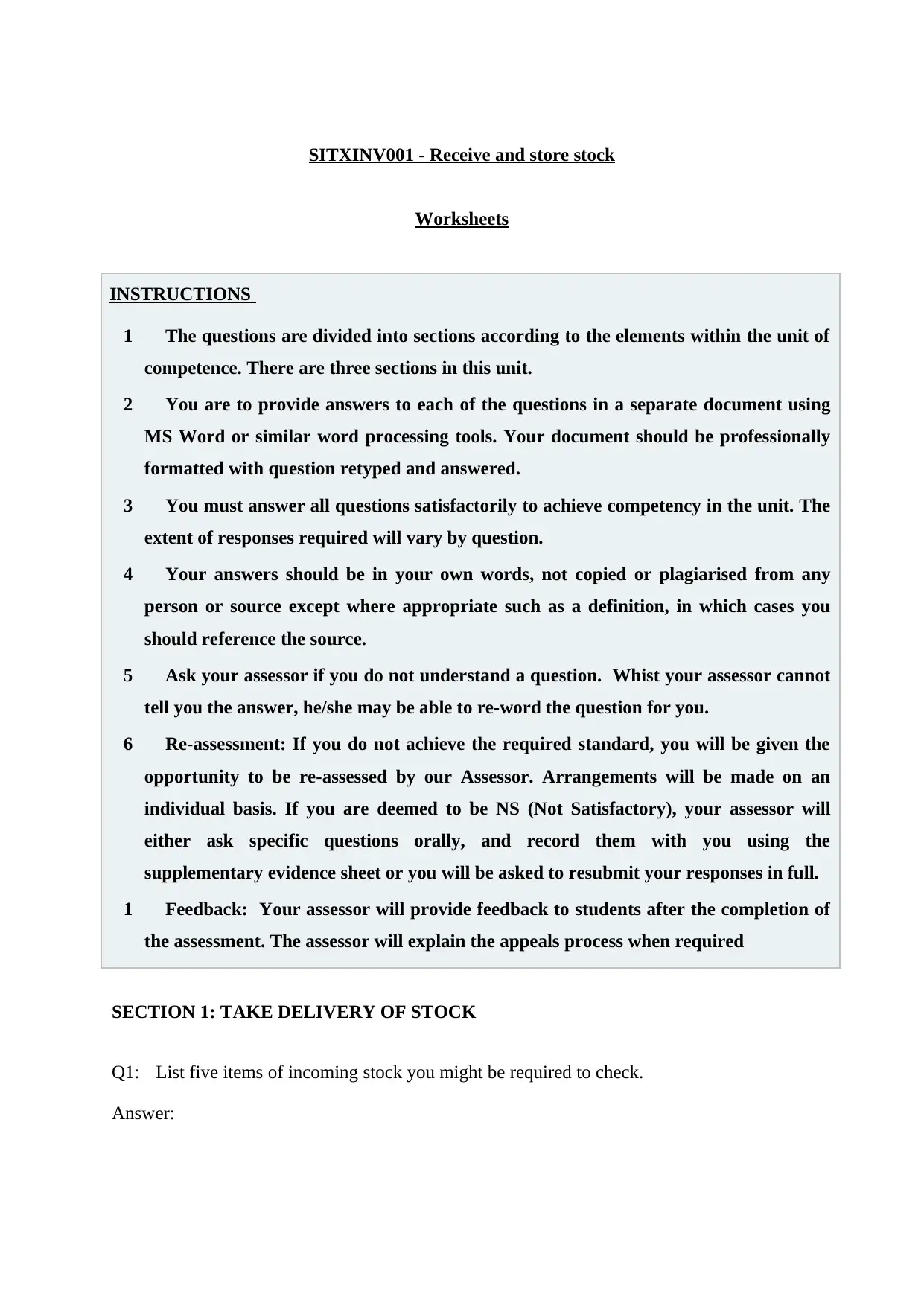
SITXINV001 - Receive and store stock
Worksheets
INSTRUCTIONS
1 The questions are divided into sections according to the elements within the unit of
competence. There are three sections in this unit.
2 You are to provide answers to each of the questions in a separate document using
MS Word or similar word processing tools. Your document should be professionally
formatted with question retyped and answered.
3 You must answer all questions satisfactorily to achieve competency in the unit. The
extent of responses required will vary by question.
4 Your answers should be in your own words, not copied or plagiarised from any
person or source except where appropriate such as a definition, in which cases you
should reference the source.
5 Ask your assessor if you do not understand a question. Whist your assessor cannot
tell you the answer, he/she may be able to re-word the question for you.
6 Re-assessment: If you do not achieve the required standard, you will be given the
opportunity to be re-assessed by our Assessor. Arrangements will be made on an
individual basis. If you are deemed to be NS (Not Satisfactory), your assessor will
either ask specific questions orally, and record them with you using the
supplementary evidence sheet or you will be asked to resubmit your responses in full.
1 Feedback: Your assessor will provide feedback to students after the completion of
the assessment. The assessor will explain the appeals process when required
SECTION 1: TAKE DELIVERY OF STOCK
Q1: List five items of incoming stock you might be required to check.
Answer:
Worksheets
INSTRUCTIONS
1 The questions are divided into sections according to the elements within the unit of
competence. There are three sections in this unit.
2 You are to provide answers to each of the questions in a separate document using
MS Word or similar word processing tools. Your document should be professionally
formatted with question retyped and answered.
3 You must answer all questions satisfactorily to achieve competency in the unit. The
extent of responses required will vary by question.
4 Your answers should be in your own words, not copied or plagiarised from any
person or source except where appropriate such as a definition, in which cases you
should reference the source.
5 Ask your assessor if you do not understand a question. Whist your assessor cannot
tell you the answer, he/she may be able to re-word the question for you.
6 Re-assessment: If you do not achieve the required standard, you will be given the
opportunity to be re-assessed by our Assessor. Arrangements will be made on an
individual basis. If you are deemed to be NS (Not Satisfactory), your assessor will
either ask specific questions orally, and record them with you using the
supplementary evidence sheet or you will be asked to resubmit your responses in full.
1 Feedback: Your assessor will provide feedback to students after the completion of
the assessment. The assessor will explain the appeals process when required
SECTION 1: TAKE DELIVERY OF STOCK
Q1: List five items of incoming stock you might be required to check.
Answer:
Paraphrase This Document
Need a fresh take? Get an instant paraphrase of this document with our AI Paraphraser
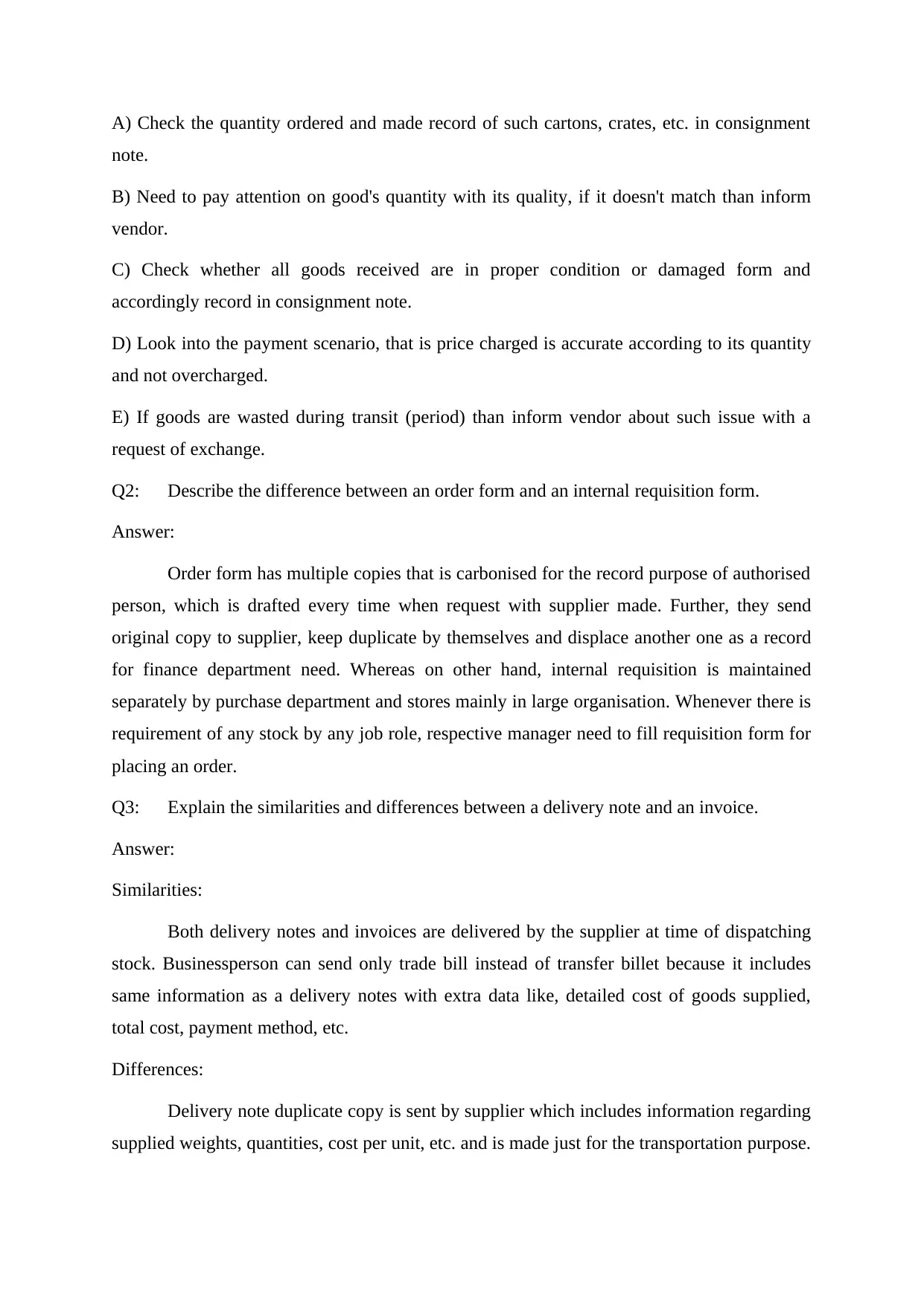
A) Check the quantity ordered and made record of such cartons, crates, etc. in consignment
note.
B) Need to pay attention on good's quantity with its quality, if it doesn't match than inform
vendor.
C) Check whether all goods received are in proper condition or damaged form and
accordingly record in consignment note.
D) Look into the payment scenario, that is price charged is accurate according to its quantity
and not overcharged.
E) If goods are wasted during transit (period) than inform vendor about such issue with a
request of exchange.
Q2: Describe the difference between an order form and an internal requisition form.
Answer:
Order form has multiple copies that is carbonised for the record purpose of authorised
person, which is drafted every time when request with supplier made. Further, they send
original copy to supplier, keep duplicate by themselves and displace another one as a record
for finance department need. Whereas on other hand, internal requisition is maintained
separately by purchase department and stores mainly in large organisation. Whenever there is
requirement of any stock by any job role, respective manager need to fill requisition form for
placing an order.
Q3: Explain the similarities and differences between a delivery note and an invoice.
Answer:
Similarities:
Both delivery notes and invoices are delivered by the supplier at time of dispatching
stock. Businessperson can send only trade bill instead of transfer billet because it includes
same information as a delivery notes with extra data like, detailed cost of goods supplied,
total cost, payment method, etc.
Differences:
Delivery note duplicate copy is sent by supplier which includes information regarding
supplied weights, quantities, cost per unit, etc. and is made just for the transportation purpose.
note.
B) Need to pay attention on good's quantity with its quality, if it doesn't match than inform
vendor.
C) Check whether all goods received are in proper condition or damaged form and
accordingly record in consignment note.
D) Look into the payment scenario, that is price charged is accurate according to its quantity
and not overcharged.
E) If goods are wasted during transit (period) than inform vendor about such issue with a
request of exchange.
Q2: Describe the difference between an order form and an internal requisition form.
Answer:
Order form has multiple copies that is carbonised for the record purpose of authorised
person, which is drafted every time when request with supplier made. Further, they send
original copy to supplier, keep duplicate by themselves and displace another one as a record
for finance department need. Whereas on other hand, internal requisition is maintained
separately by purchase department and stores mainly in large organisation. Whenever there is
requirement of any stock by any job role, respective manager need to fill requisition form for
placing an order.
Q3: Explain the similarities and differences between a delivery note and an invoice.
Answer:
Similarities:
Both delivery notes and invoices are delivered by the supplier at time of dispatching
stock. Businessperson can send only trade bill instead of transfer billet because it includes
same information as a delivery notes with extra data like, detailed cost of goods supplied,
total cost, payment method, etc.
Differences:
Delivery note duplicate copy is sent by supplier which includes information regarding
supplied weights, quantities, cost per unit, etc. and is made just for the transportation purpose.
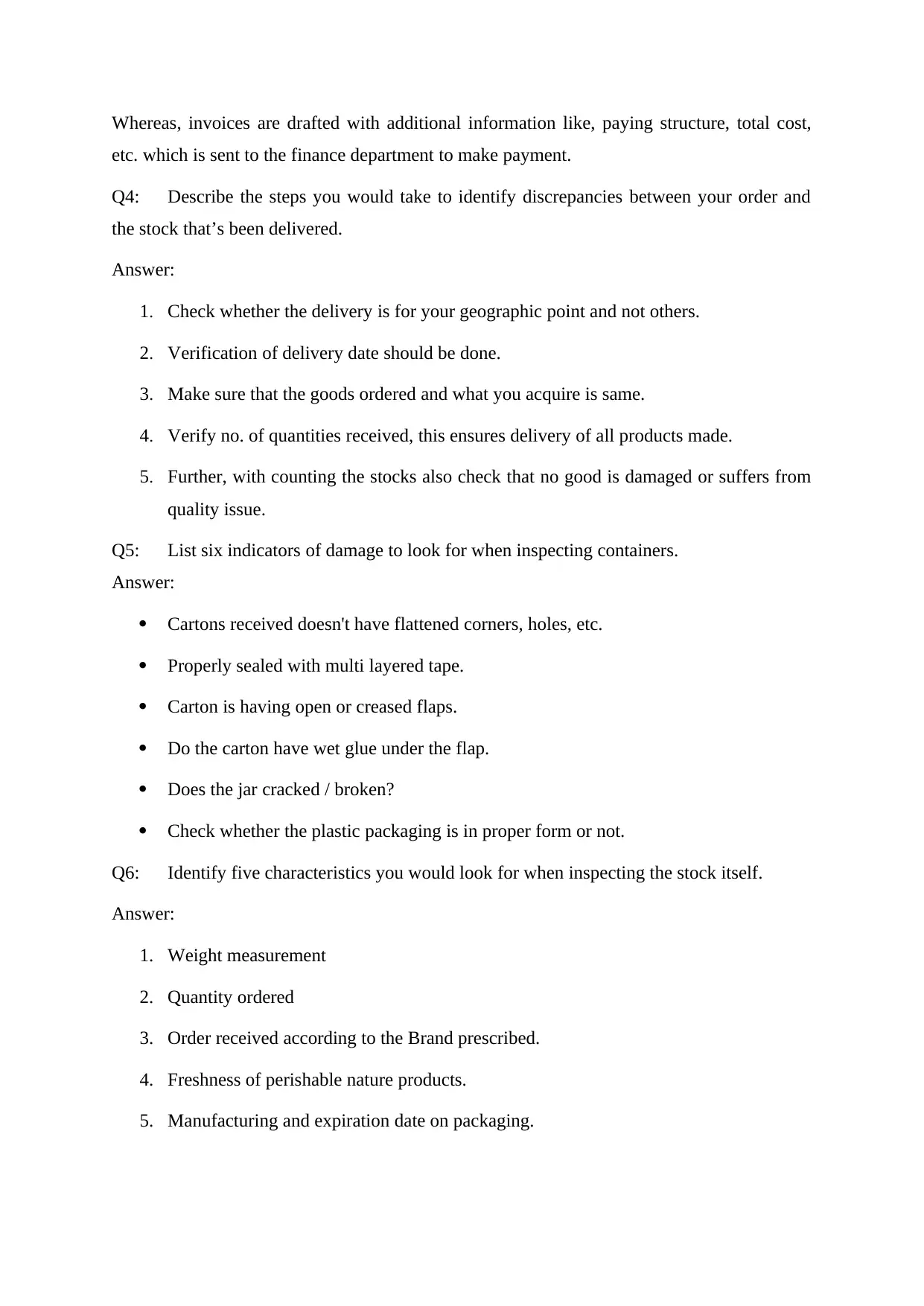
Whereas, invoices are drafted with additional information like, paying structure, total cost,
etc. which is sent to the finance department to make payment.
Q4: Describe the steps you would take to identify discrepancies between your order and
the stock that’s been delivered.
Answer:
1. Check whether the delivery is for your geographic point and not others.
2. Verification of delivery date should be done.
3. Make sure that the goods ordered and what you acquire is same.
4. Verify no. of quantities received, this ensures delivery of all products made.
5. Further, with counting the stocks also check that no good is damaged or suffers from
quality issue.
Q5: List six indicators of damage to look for when inspecting containers.
Answer:
Cartons received doesn't have flattened corners, holes, etc.
Properly sealed with multi layered tape.
Carton is having open or creased flaps.
Do the carton have wet glue under the flap.
Does the jar cracked / broken?
Check whether the plastic packaging is in proper form or not.
Q6: Identify five characteristics you would look for when inspecting the stock itself.
Answer:
1. Weight measurement
2. Quantity ordered
3. Order received according to the Brand prescribed.
4. Freshness of perishable nature products.
5. Manufacturing and expiration date on packaging.
etc. which is sent to the finance department to make payment.
Q4: Describe the steps you would take to identify discrepancies between your order and
the stock that’s been delivered.
Answer:
1. Check whether the delivery is for your geographic point and not others.
2. Verification of delivery date should be done.
3. Make sure that the goods ordered and what you acquire is same.
4. Verify no. of quantities received, this ensures delivery of all products made.
5. Further, with counting the stocks also check that no good is damaged or suffers from
quality issue.
Q5: List six indicators of damage to look for when inspecting containers.
Answer:
Cartons received doesn't have flattened corners, holes, etc.
Properly sealed with multi layered tape.
Carton is having open or creased flaps.
Do the carton have wet glue under the flap.
Does the jar cracked / broken?
Check whether the plastic packaging is in proper form or not.
Q6: Identify five characteristics you would look for when inspecting the stock itself.
Answer:
1. Weight measurement
2. Quantity ordered
3. Order received according to the Brand prescribed.
4. Freshness of perishable nature products.
5. Manufacturing and expiration date on packaging.
⊘ This is a preview!⊘
Do you want full access?
Subscribe today to unlock all pages.

Trusted by 1+ million students worldwide
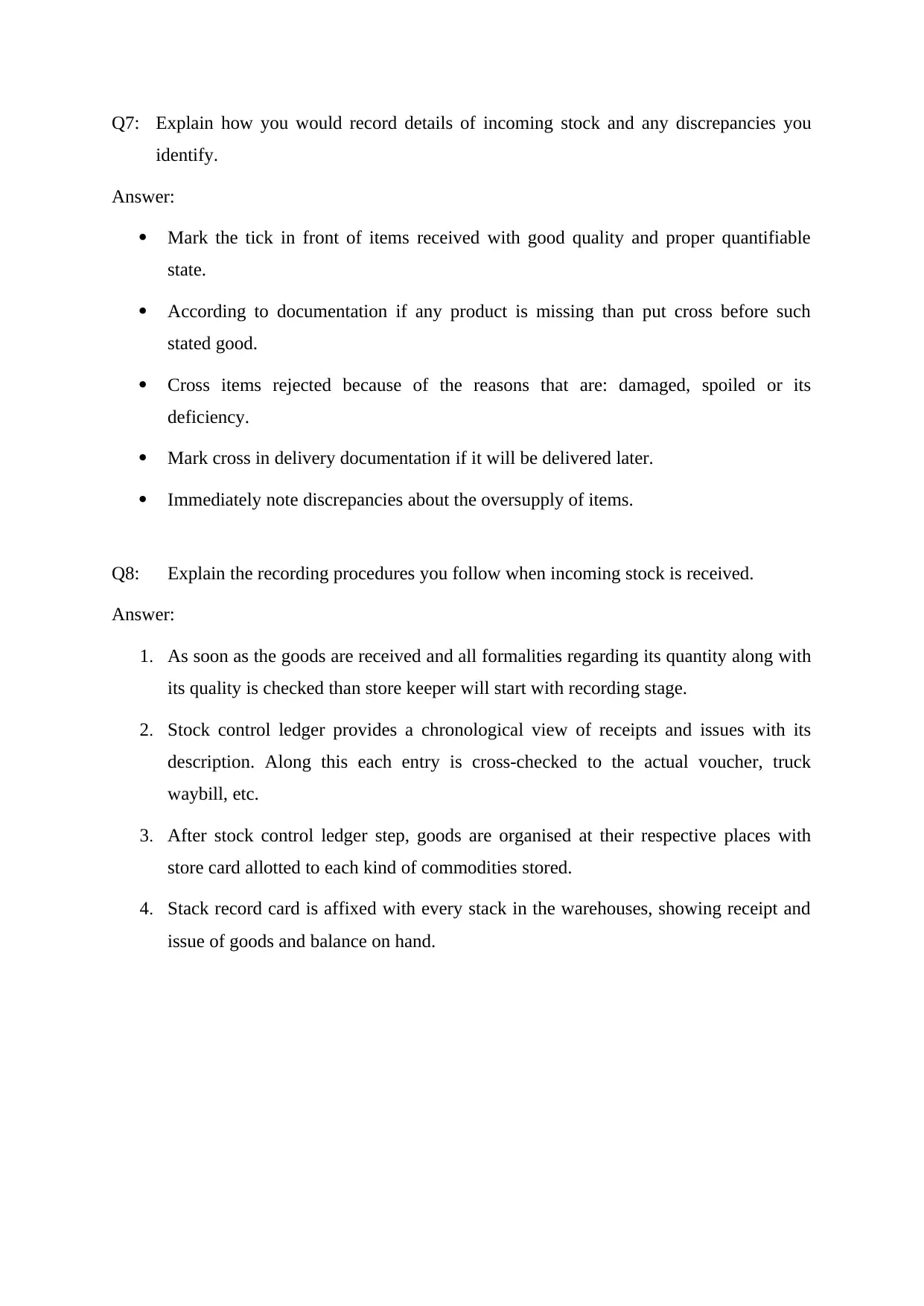
Q7: Explain how you would record details of incoming stock and any discrepancies you
identify.
Answer:
Mark the tick in front of items received with good quality and proper quantifiable
state.
According to documentation if any product is missing than put cross before such
stated good.
Cross items rejected because of the reasons that are: damaged, spoiled or its
deficiency.
Mark cross in delivery documentation if it will be delivered later.
Immediately note discrepancies about the oversupply of items.
Q8: Explain the recording procedures you follow when incoming stock is received.
Answer:
1. As soon as the goods are received and all formalities regarding its quantity along with
its quality is checked than store keeper will start with recording stage.
2. Stock control ledger provides a chronological view of receipts and issues with its
description. Along this each entry is cross-checked to the actual voucher, truck
waybill, etc.
3. After stock control ledger step, goods are organised at their respective places with
store card allotted to each kind of commodities stored.
4. Stack record card is affixed with every stack in the warehouses, showing receipt and
issue of goods and balance on hand.
identify.
Answer:
Mark the tick in front of items received with good quality and proper quantifiable
state.
According to documentation if any product is missing than put cross before such
stated good.
Cross items rejected because of the reasons that are: damaged, spoiled or its
deficiency.
Mark cross in delivery documentation if it will be delivered later.
Immediately note discrepancies about the oversupply of items.
Q8: Explain the recording procedures you follow when incoming stock is received.
Answer:
1. As soon as the goods are received and all formalities regarding its quantity along with
its quality is checked than store keeper will start with recording stage.
2. Stock control ledger provides a chronological view of receipts and issues with its
description. Along this each entry is cross-checked to the actual voucher, truck
waybill, etc.
3. After stock control ledger step, goods are organised at their respective places with
store card allotted to each kind of commodities stored.
4. Stack record card is affixed with every stack in the warehouses, showing receipt and
issue of goods and balance on hand.
Paraphrase This Document
Need a fresh take? Get an instant paraphrase of this document with our AI Paraphraser
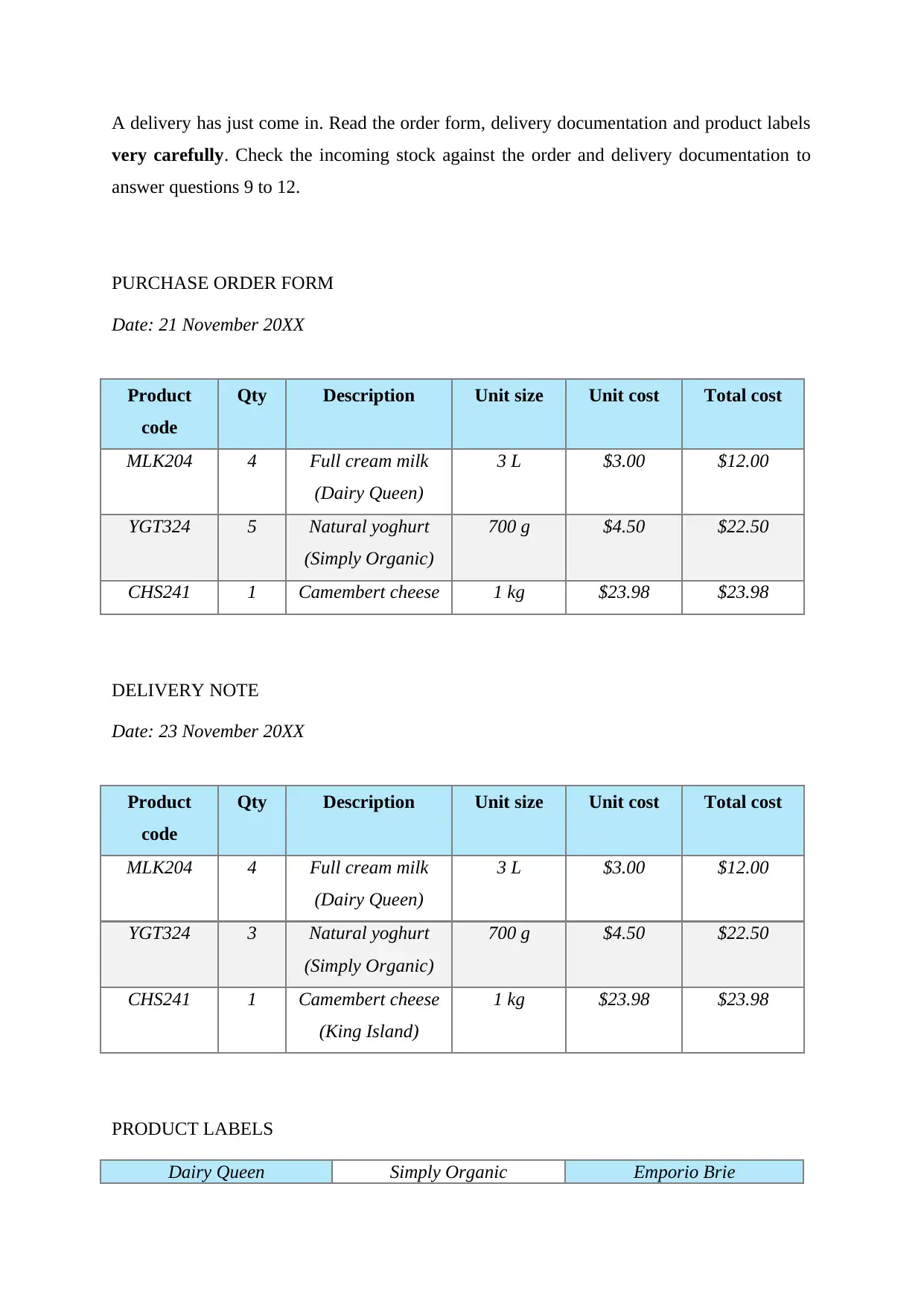
A delivery has just come in. Read the order form, delivery documentation and product labels
very carefully. Check the incoming stock against the order and delivery documentation to
answer questions 9 to 12.
PURCHASE ORDER FORM
Date: 21 November 20XX
Product
code
Qty Description Unit size Unit cost Total cost
MLK204 4 Full cream milk
(Dairy Queen)
3 L $3.00 $12.00
YGT324 5 Natural yoghurt
(Simply Organic)
700 g $4.50 $22.50
CHS241 1 Camembert cheese 1 kg $23.98 $23.98
DELIVERY NOTE
Date: 23 November 20XX
Product
code
Qty Description Unit size Unit cost Total cost
MLK204 4 Full cream milk
(Dairy Queen)
3 L $3.00 $12.00
YGT324 3 Natural yoghurt
(Simply Organic)
700 g $4.50 $22.50
CHS241 1 Camembert cheese
(King Island)
1 kg $23.98 $23.98
PRODUCT LABELS
Dairy Queen Simply Organic Emporio Brie
very carefully. Check the incoming stock against the order and delivery documentation to
answer questions 9 to 12.
PURCHASE ORDER FORM
Date: 21 November 20XX
Product
code
Qty Description Unit size Unit cost Total cost
MLK204 4 Full cream milk
(Dairy Queen)
3 L $3.00 $12.00
YGT324 5 Natural yoghurt
(Simply Organic)
700 g $4.50 $22.50
CHS241 1 Camembert cheese 1 kg $23.98 $23.98
DELIVERY NOTE
Date: 23 November 20XX
Product
code
Qty Description Unit size Unit cost Total cost
MLK204 4 Full cream milk
(Dairy Queen)
3 L $3.00 $12.00
YGT324 3 Natural yoghurt
(Simply Organic)
700 g $4.50 $22.50
CHS241 1 Camembert cheese
(King Island)
1 kg $23.98 $23.98
PRODUCT LABELS
Dairy Queen Simply Organic Emporio Brie
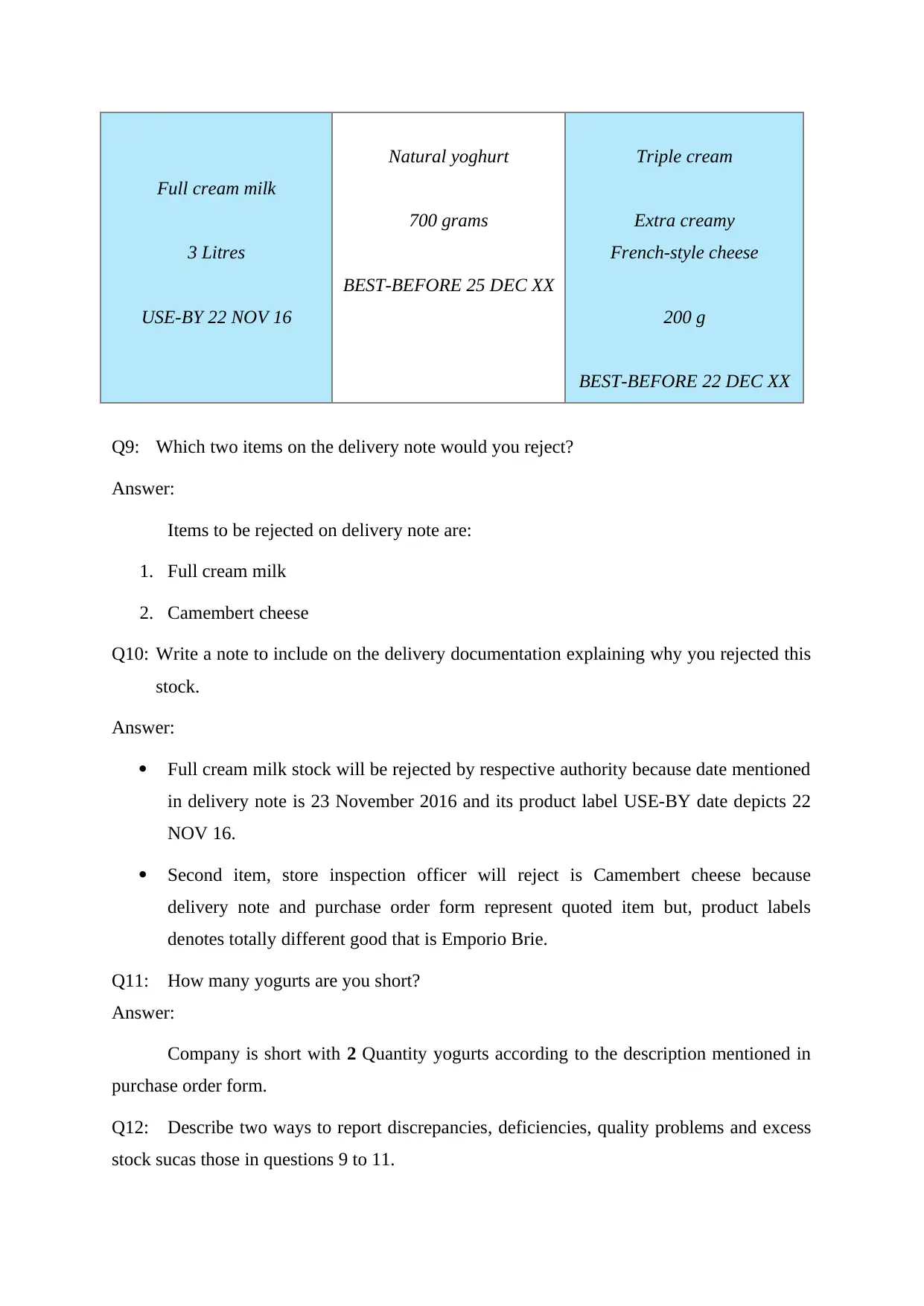
Full cream milk
3 Litres
USE-BY 22 NOV 16
Natural yoghurt
700 grams
BEST-BEFORE 25 DEC XX
Triple cream
Extra creamy
French-style cheese
200 g
BEST-BEFORE 22 DEC XX
Q9: Which two items on the delivery note would you reject?
Answer:
Items to be rejected on delivery note are:
1. Full cream milk
2. Camembert cheese
Q10: Write a note to include on the delivery documentation explaining why you rejected this
stock.
Answer:
Full cream milk stock will be rejected by respective authority because date mentioned
in delivery note is 23 November 2016 and its product label USE-BY date depicts 22
NOV 16.
Second item, store inspection officer will reject is Camembert cheese because
delivery note and purchase order form represent quoted item but, product labels
denotes totally different good that is Emporio Brie.
Q11: How many yogurts are you short?
Answer:
Company is short with 2 Quantity yogurts according to the description mentioned in
purchase order form.
Q12: Describe two ways to report discrepancies, deficiencies, quality problems and excess
stock sucas those in questions 9 to 11.
3 Litres
USE-BY 22 NOV 16
Natural yoghurt
700 grams
BEST-BEFORE 25 DEC XX
Triple cream
Extra creamy
French-style cheese
200 g
BEST-BEFORE 22 DEC XX
Q9: Which two items on the delivery note would you reject?
Answer:
Items to be rejected on delivery note are:
1. Full cream milk
2. Camembert cheese
Q10: Write a note to include on the delivery documentation explaining why you rejected this
stock.
Answer:
Full cream milk stock will be rejected by respective authority because date mentioned
in delivery note is 23 November 2016 and its product label USE-BY date depicts 22
NOV 16.
Second item, store inspection officer will reject is Camembert cheese because
delivery note and purchase order form represent quoted item but, product labels
denotes totally different good that is Emporio Brie.
Q11: How many yogurts are you short?
Answer:
Company is short with 2 Quantity yogurts according to the description mentioned in
purchase order form.
Q12: Describe two ways to report discrepancies, deficiencies, quality problems and excess
stock sucas those in questions 9 to 11.
⊘ This is a preview!⊘
Do you want full access?
Subscribe today to unlock all pages.

Trusted by 1+ million students worldwide
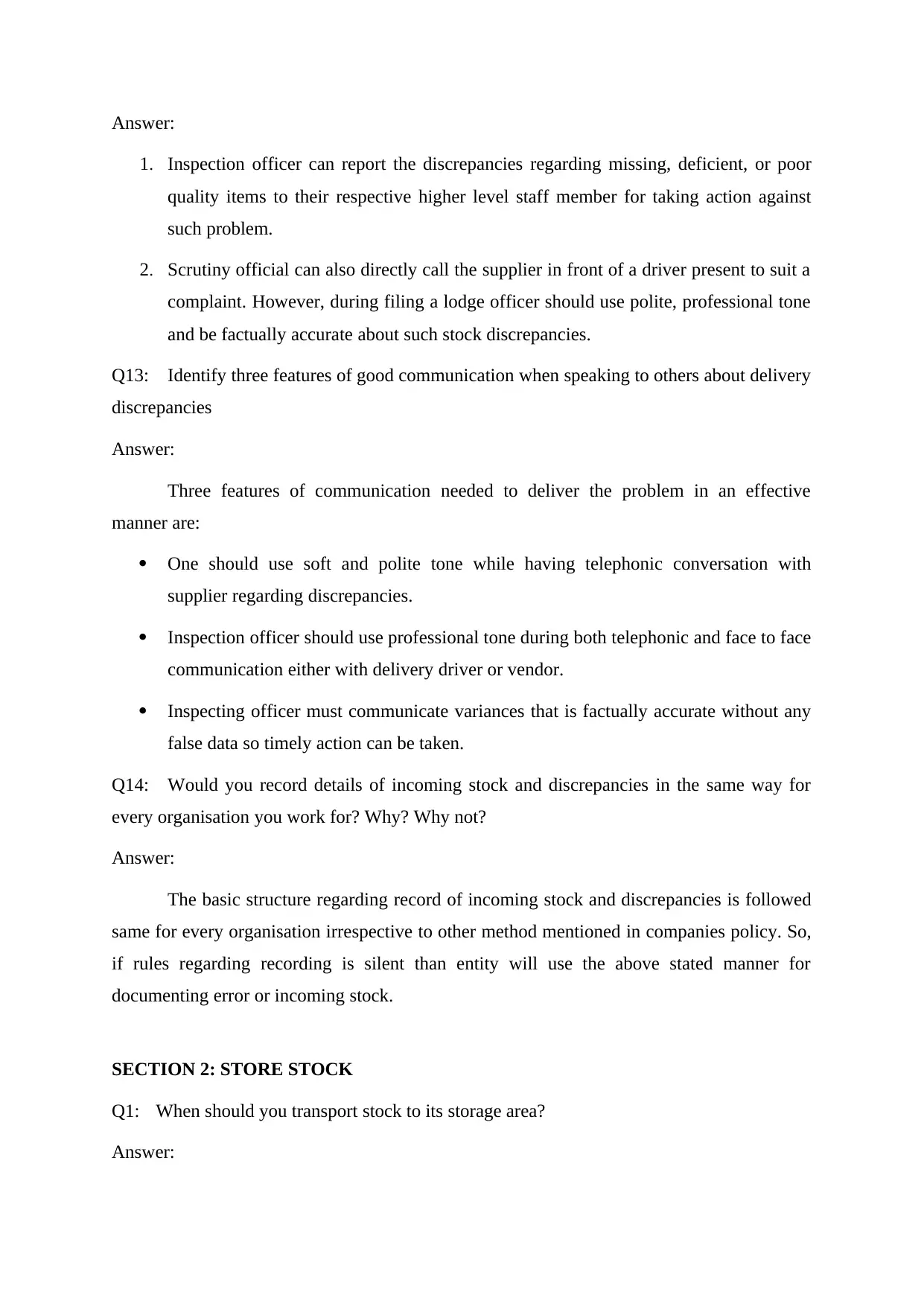
Answer:
1. Inspection officer can report the discrepancies regarding missing, deficient, or poor
quality items to their respective higher level staff member for taking action against
such problem.
2. Scrutiny official can also directly call the supplier in front of a driver present to suit a
complaint. However, during filing a lodge officer should use polite, professional tone
and be factually accurate about such stock discrepancies.
Q13: Identify three features of good communication when speaking to others about delivery
discrepancies
Answer:
Three features of communication needed to deliver the problem in an effective
manner are:
One should use soft and polite tone while having telephonic conversation with
supplier regarding discrepancies.
Inspection officer should use professional tone during both telephonic and face to face
communication either with delivery driver or vendor.
Inspecting officer must communicate variances that is factually accurate without any
false data so timely action can be taken.
Q14: Would you record details of incoming stock and discrepancies in the same way for
every organisation you work for? Why? Why not?
Answer:
The basic structure regarding record of incoming stock and discrepancies is followed
same for every organisation irrespective to other method mentioned in companies policy. So,
if rules regarding recording is silent than entity will use the above stated manner for
documenting error or incoming stock.
SECTION 2: STORE STOCK
Q1: When should you transport stock to its storage area?
Answer:
1. Inspection officer can report the discrepancies regarding missing, deficient, or poor
quality items to their respective higher level staff member for taking action against
such problem.
2. Scrutiny official can also directly call the supplier in front of a driver present to suit a
complaint. However, during filing a lodge officer should use polite, professional tone
and be factually accurate about such stock discrepancies.
Q13: Identify three features of good communication when speaking to others about delivery
discrepancies
Answer:
Three features of communication needed to deliver the problem in an effective
manner are:
One should use soft and polite tone while having telephonic conversation with
supplier regarding discrepancies.
Inspection officer should use professional tone during both telephonic and face to face
communication either with delivery driver or vendor.
Inspecting officer must communicate variances that is factually accurate without any
false data so timely action can be taken.
Q14: Would you record details of incoming stock and discrepancies in the same way for
every organisation you work for? Why? Why not?
Answer:
The basic structure regarding record of incoming stock and discrepancies is followed
same for every organisation irrespective to other method mentioned in companies policy. So,
if rules regarding recording is silent than entity will use the above stated manner for
documenting error or incoming stock.
SECTION 2: STORE STOCK
Q1: When should you transport stock to its storage area?
Answer:
Paraphrase This Document
Need a fresh take? Get an instant paraphrase of this document with our AI Paraphraser
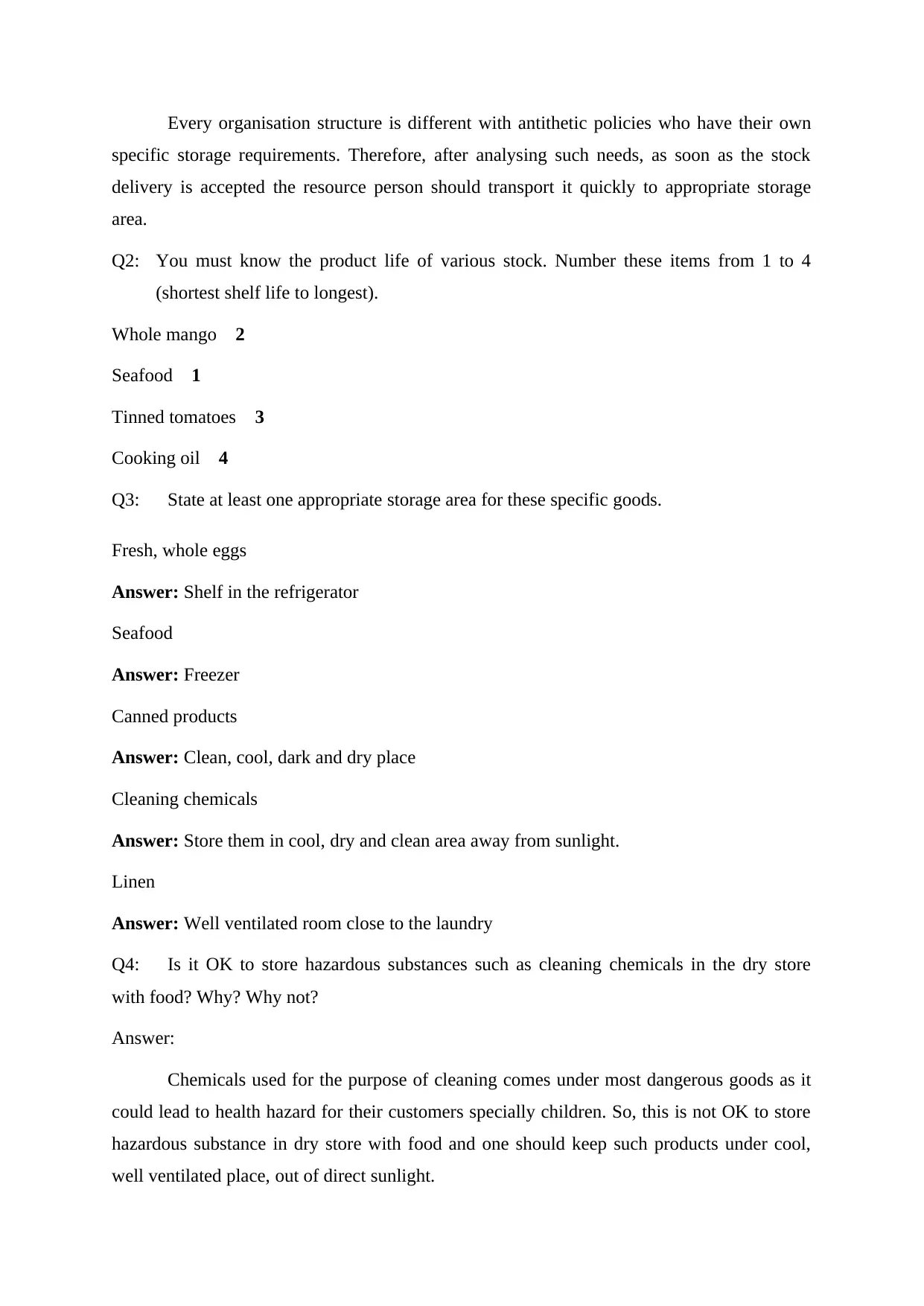
Every organisation structure is different with antithetic policies who have their own
specific storage requirements. Therefore, after analysing such needs, as soon as the stock
delivery is accepted the resource person should transport it quickly to appropriate storage
area.
Q2: You must know the product life of various stock. Number these items from 1 to 4
(shortest shelf life to longest).
Whole mango 2
Seafood 1
Tinned tomatoes 3
Cooking oil 4
Q3: State at least one appropriate storage area for these specific goods.
Fresh, whole eggs
Answer: Shelf in the refrigerator
Seafood
Answer: Freezer
Canned products
Answer: Clean, cool, dark and dry place
Cleaning chemicals
Answer: Store them in cool, dry and clean area away from sunlight.
Linen
Answer: Well ventilated room close to the laundry
Q4: Is it OK to store hazardous substances such as cleaning chemicals in the dry store
with food? Why? Why not?
Answer:
Chemicals used for the purpose of cleaning comes under most dangerous goods as it
could lead to health hazard for their customers specially children. So, this is not OK to store
hazardous substance in dry store with food and one should keep such products under cool,
well ventilated place, out of direct sunlight.
specific storage requirements. Therefore, after analysing such needs, as soon as the stock
delivery is accepted the resource person should transport it quickly to appropriate storage
area.
Q2: You must know the product life of various stock. Number these items from 1 to 4
(shortest shelf life to longest).
Whole mango 2
Seafood 1
Tinned tomatoes 3
Cooking oil 4
Q3: State at least one appropriate storage area for these specific goods.
Fresh, whole eggs
Answer: Shelf in the refrigerator
Seafood
Answer: Freezer
Canned products
Answer: Clean, cool, dark and dry place
Cleaning chemicals
Answer: Store them in cool, dry and clean area away from sunlight.
Linen
Answer: Well ventilated room close to the laundry
Q4: Is it OK to store hazardous substances such as cleaning chemicals in the dry store
with food? Why? Why not?
Answer:
Chemicals used for the purpose of cleaning comes under most dangerous goods as it
could lead to health hazard for their customers specially children. So, this is not OK to store
hazardous substance in dry store with food and one should keep such products under cool,
well ventilated place, out of direct sunlight.
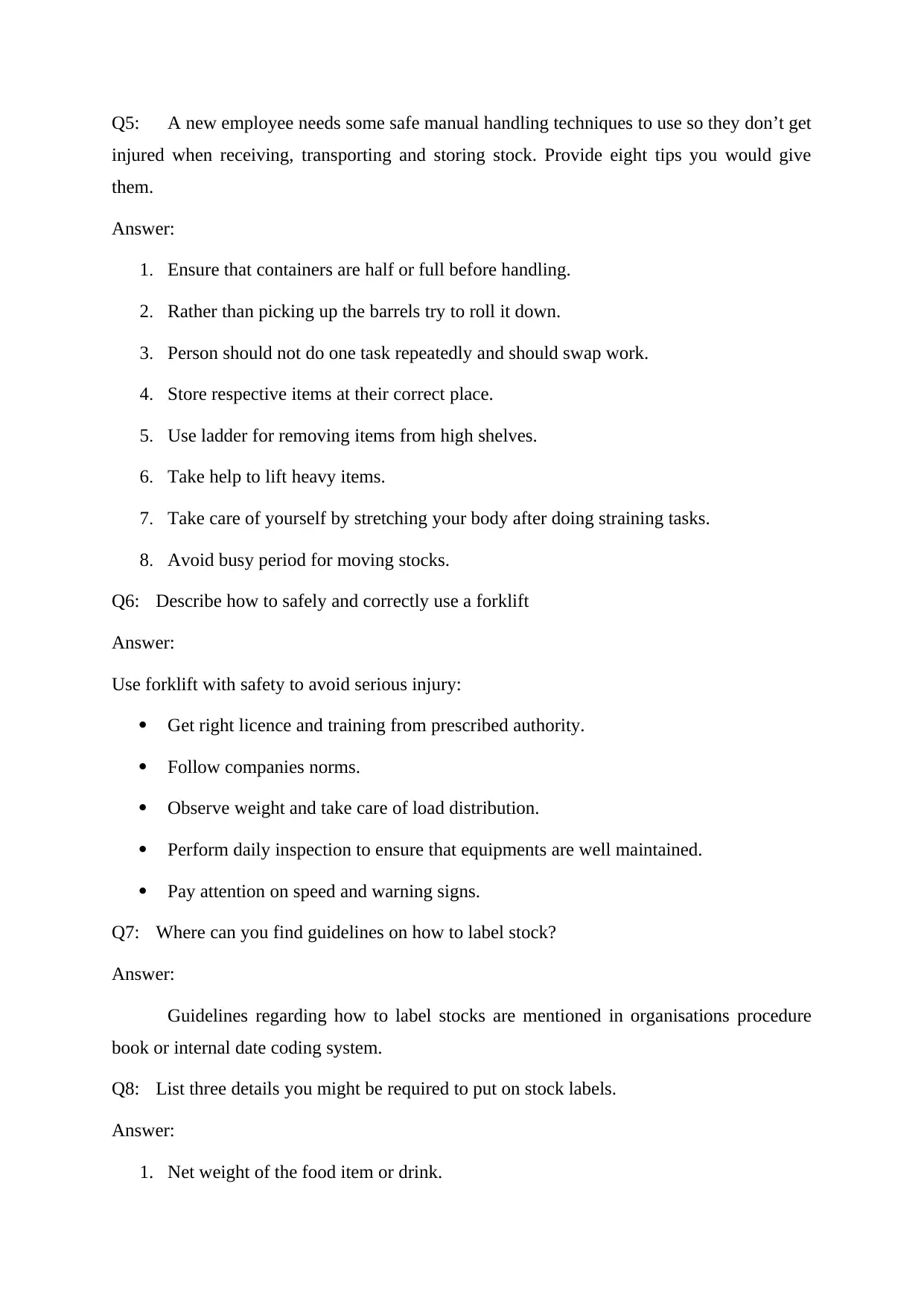
Q5: A new employee needs some safe manual handling techniques to use so they don’t get
injured when receiving, transporting and storing stock. Provide eight tips you would give
them.
Answer:
1. Ensure that containers are half or full before handling.
2. Rather than picking up the barrels try to roll it down.
3. Person should not do one task repeatedly and should swap work.
4. Store respective items at their correct place.
5. Use ladder for removing items from high shelves.
6. Take help to lift heavy items.
7. Take care of yourself by stretching your body after doing straining tasks.
8. Avoid busy period for moving stocks.
Q6: Describe how to safely and correctly use a forklift
Answer:
Use forklift with safety to avoid serious injury:
Get right licence and training from prescribed authority.
Follow companies norms.
Observe weight and take care of load distribution.
Perform daily inspection to ensure that equipments are well maintained.
Pay attention on speed and warning signs.
Q7: Where can you find guidelines on how to label stock?
Answer:
Guidelines regarding how to label stocks are mentioned in organisations procedure
book or internal date coding system.
Q8: List three details you might be required to put on stock labels.
Answer:
1. Net weight of the food item or drink.
injured when receiving, transporting and storing stock. Provide eight tips you would give
them.
Answer:
1. Ensure that containers are half or full before handling.
2. Rather than picking up the barrels try to roll it down.
3. Person should not do one task repeatedly and should swap work.
4. Store respective items at their correct place.
5. Use ladder for removing items from high shelves.
6. Take help to lift heavy items.
7. Take care of yourself by stretching your body after doing straining tasks.
8. Avoid busy period for moving stocks.
Q6: Describe how to safely and correctly use a forklift
Answer:
Use forklift with safety to avoid serious injury:
Get right licence and training from prescribed authority.
Follow companies norms.
Observe weight and take care of load distribution.
Perform daily inspection to ensure that equipments are well maintained.
Pay attention on speed and warning signs.
Q7: Where can you find guidelines on how to label stock?
Answer:
Guidelines regarding how to label stocks are mentioned in organisations procedure
book or internal date coding system.
Q8: List three details you might be required to put on stock labels.
Answer:
1. Net weight of the food item or drink.
⊘ This is a preview!⊘
Do you want full access?
Subscribe today to unlock all pages.

Trusted by 1+ million students worldwide
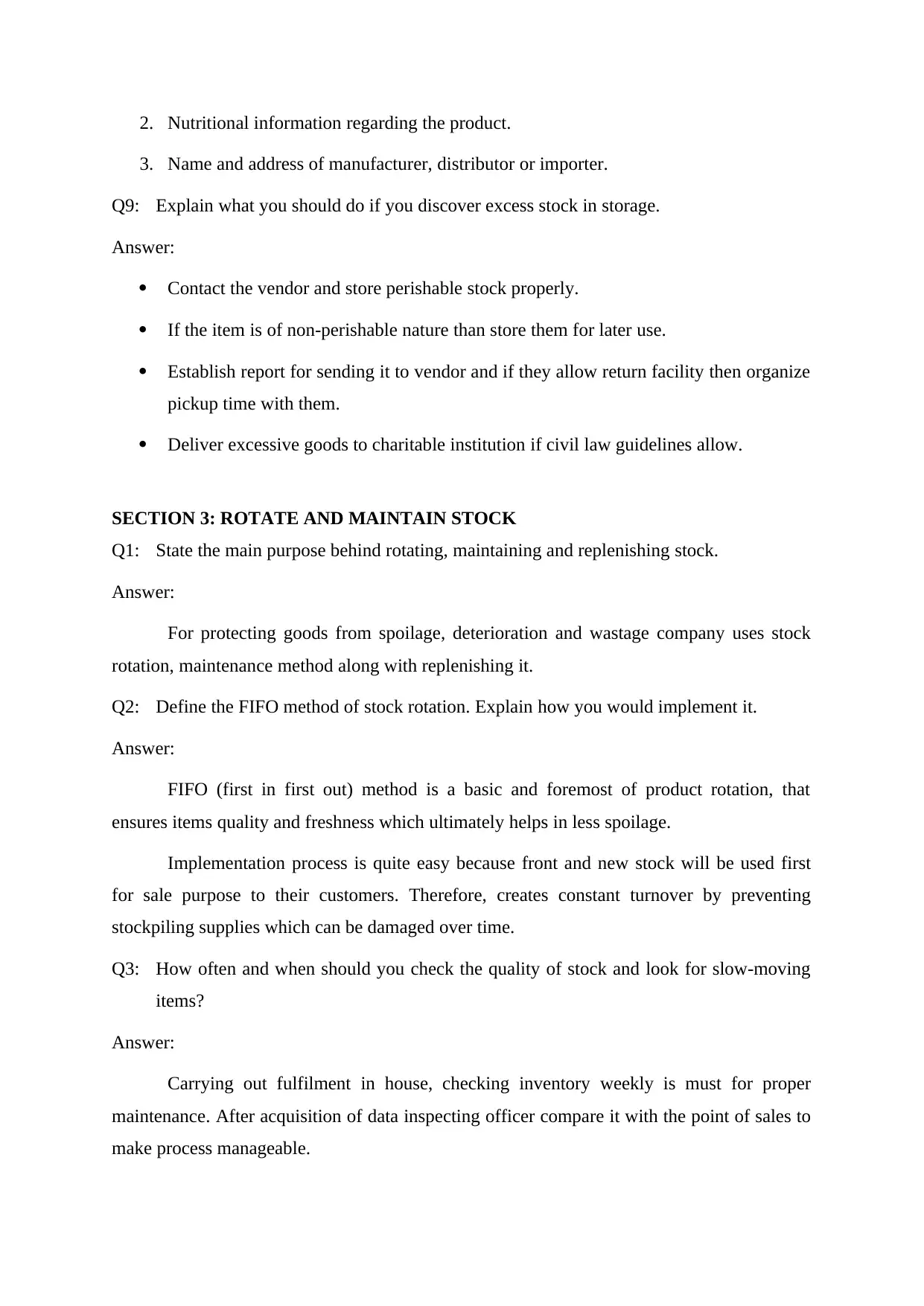
2. Nutritional information regarding the product.
3. Name and address of manufacturer, distributor or importer.
Q9: Explain what you should do if you discover excess stock in storage.
Answer:
Contact the vendor and store perishable stock properly.
If the item is of non-perishable nature than store them for later use.
Establish report for sending it to vendor and if they allow return facility then organize
pickup time with them.
Deliver excessive goods to charitable institution if civil law guidelines allow.
SECTION 3: ROTATE AND MAINTAIN STOCK
Q1: State the main purpose behind rotating, maintaining and replenishing stock.
Answer:
For protecting goods from spoilage, deterioration and wastage company uses stock
rotation, maintenance method along with replenishing it.
Q2: Define the FIFO method of stock rotation. Explain how you would implement it.
Answer:
FIFO (first in first out) method is a basic and foremost of product rotation, that
ensures items quality and freshness which ultimately helps in less spoilage.
Implementation process is quite easy because front and new stock will be used first
for sale purpose to their customers. Therefore, creates constant turnover by preventing
stockpiling supplies which can be damaged over time.
Q3: How often and when should you check the quality of stock and look for slow-moving
items?
Answer:
Carrying out fulfilment in house, checking inventory weekly is must for proper
maintenance. After acquisition of data inspecting officer compare it with the point of sales to
make process manageable.
3. Name and address of manufacturer, distributor or importer.
Q9: Explain what you should do if you discover excess stock in storage.
Answer:
Contact the vendor and store perishable stock properly.
If the item is of non-perishable nature than store them for later use.
Establish report for sending it to vendor and if they allow return facility then organize
pickup time with them.
Deliver excessive goods to charitable institution if civil law guidelines allow.
SECTION 3: ROTATE AND MAINTAIN STOCK
Q1: State the main purpose behind rotating, maintaining and replenishing stock.
Answer:
For protecting goods from spoilage, deterioration and wastage company uses stock
rotation, maintenance method along with replenishing it.
Q2: Define the FIFO method of stock rotation. Explain how you would implement it.
Answer:
FIFO (first in first out) method is a basic and foremost of product rotation, that
ensures items quality and freshness which ultimately helps in less spoilage.
Implementation process is quite easy because front and new stock will be used first
for sale purpose to their customers. Therefore, creates constant turnover by preventing
stockpiling supplies which can be damaged over time.
Q3: How often and when should you check the quality of stock and look for slow-moving
items?
Answer:
Carrying out fulfilment in house, checking inventory weekly is must for proper
maintenance. After acquisition of data inspecting officer compare it with the point of sales to
make process manageable.
Paraphrase This Document
Need a fresh take? Get an instant paraphrase of this document with our AI Paraphraser
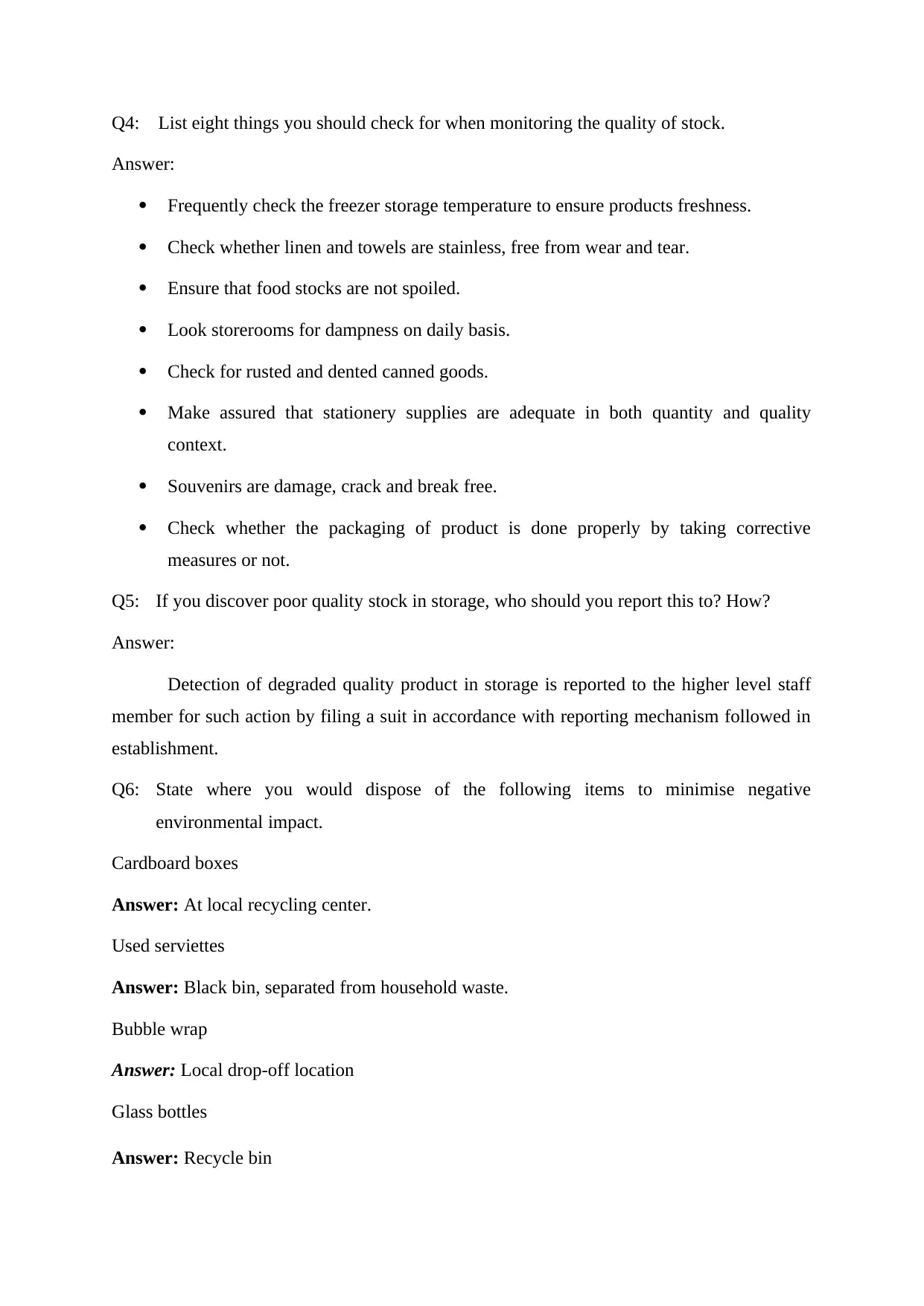
Q4: List eight things you should check for when monitoring the quality of stock.
Answer:
Frequently check the freezer storage temperature to ensure products freshness.
Check whether linen and towels are stainless, free from wear and tear.
Ensure that food stocks are not spoiled.
Look storerooms for dampness on daily basis.
Check for rusted and dented canned goods.
Make assured that stationery supplies are adequate in both quantity and quality
context.
Souvenirs are damage, crack and break free.
Check whether the packaging of product is done properly by taking corrective
measures or not.
Q5: If you discover poor quality stock in storage, who should you report this to? How?
Answer:
Detection of degraded quality product in storage is reported to the higher level staff
member for such action by filing a suit in accordance with reporting mechanism followed in
establishment.
Q6: State where you would dispose of the following items to minimise negative
environmental impact.
Cardboard boxes
Answer: At local recycling center.
Used serviettes
Answer: Black bin, separated from household waste.
Bubble wrap
Answer: Local drop-off location
Glass bottles
Answer: Recycle bin
Answer:
Frequently check the freezer storage temperature to ensure products freshness.
Check whether linen and towels are stainless, free from wear and tear.
Ensure that food stocks are not spoiled.
Look storerooms for dampness on daily basis.
Check for rusted and dented canned goods.
Make assured that stationery supplies are adequate in both quantity and quality
context.
Souvenirs are damage, crack and break free.
Check whether the packaging of product is done properly by taking corrective
measures or not.
Q5: If you discover poor quality stock in storage, who should you report this to? How?
Answer:
Detection of degraded quality product in storage is reported to the higher level staff
member for such action by filing a suit in accordance with reporting mechanism followed in
establishment.
Q6: State where you would dispose of the following items to minimise negative
environmental impact.
Cardboard boxes
Answer: At local recycling center.
Used serviettes
Answer: Black bin, separated from household waste.
Bubble wrap
Answer: Local drop-off location
Glass bottles
Answer: Recycle bin
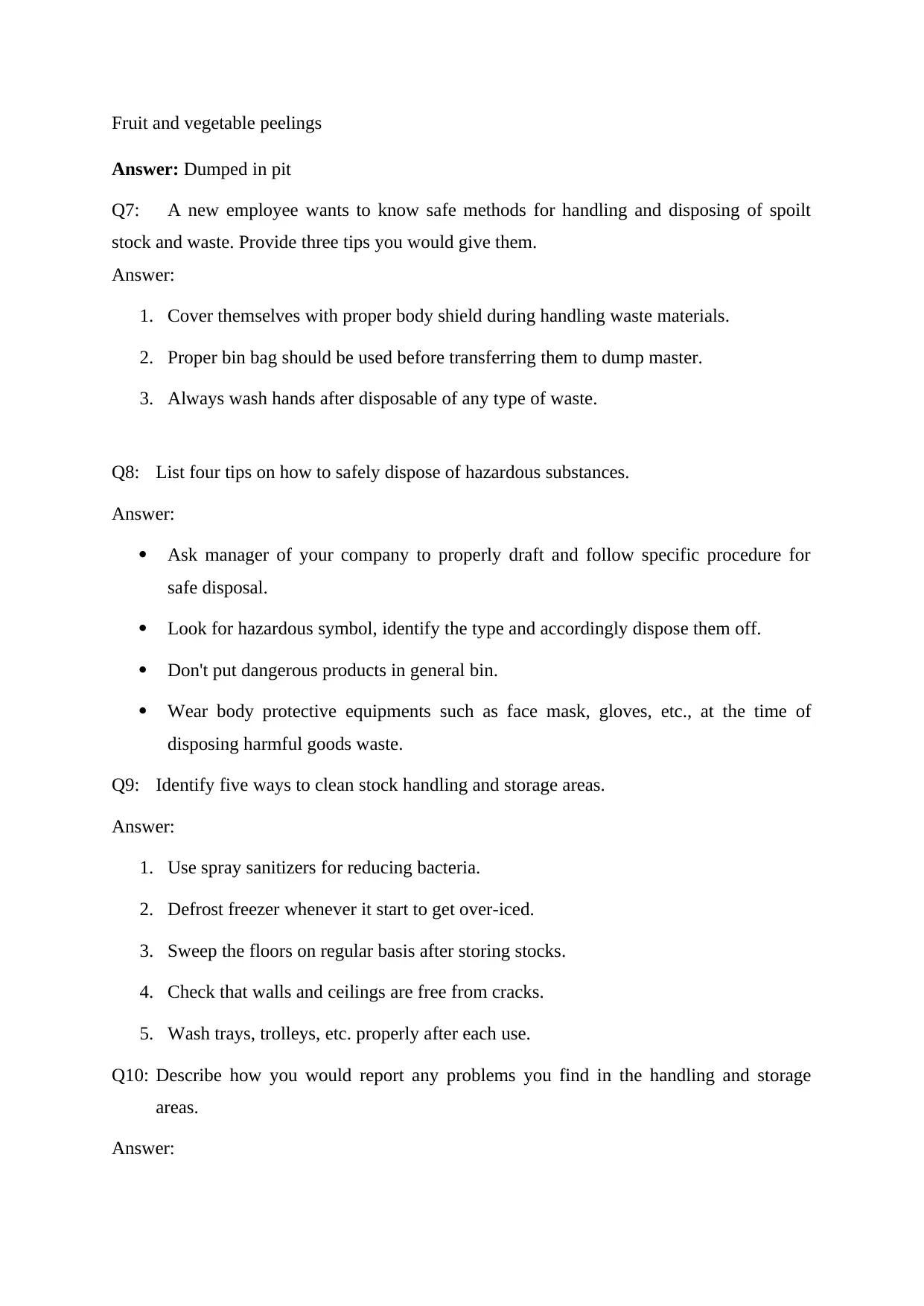
Fruit and vegetable peelings
Answer: Dumped in pit
Q7: A new employee wants to know safe methods for handling and disposing of spoilt
stock and waste. Provide three tips you would give them.
Answer:
1. Cover themselves with proper body shield during handling waste materials.
2. Proper bin bag should be used before transferring them to dump master.
3. Always wash hands after disposable of any type of waste.
Q8: List four tips on how to safely dispose of hazardous substances.
Answer:
Ask manager of your company to properly draft and follow specific procedure for
safe disposal.
Look for hazardous symbol, identify the type and accordingly dispose them off.
Don't put dangerous products in general bin.
Wear body protective equipments such as face mask, gloves, etc., at the time of
disposing harmful goods waste.
Q9: Identify five ways to clean stock handling and storage areas.
Answer:
1. Use spray sanitizers for reducing bacteria.
2. Defrost freezer whenever it start to get over-iced.
3. Sweep the floors on regular basis after storing stocks.
4. Check that walls and ceilings are free from cracks.
5. Wash trays, trolleys, etc. properly after each use.
Q10: Describe how you would report any problems you find in the handling and storage
areas.
Answer:
Answer: Dumped in pit
Q7: A new employee wants to know safe methods for handling and disposing of spoilt
stock and waste. Provide three tips you would give them.
Answer:
1. Cover themselves with proper body shield during handling waste materials.
2. Proper bin bag should be used before transferring them to dump master.
3. Always wash hands after disposable of any type of waste.
Q8: List four tips on how to safely dispose of hazardous substances.
Answer:
Ask manager of your company to properly draft and follow specific procedure for
safe disposal.
Look for hazardous symbol, identify the type and accordingly dispose them off.
Don't put dangerous products in general bin.
Wear body protective equipments such as face mask, gloves, etc., at the time of
disposing harmful goods waste.
Q9: Identify five ways to clean stock handling and storage areas.
Answer:
1. Use spray sanitizers for reducing bacteria.
2. Defrost freezer whenever it start to get over-iced.
3. Sweep the floors on regular basis after storing stocks.
4. Check that walls and ceilings are free from cracks.
5. Wash trays, trolleys, etc. properly after each use.
Q10: Describe how you would report any problems you find in the handling and storage
areas.
Answer:
⊘ This is a preview!⊘
Do you want full access?
Subscribe today to unlock all pages.

Trusted by 1+ million students worldwide
1 out of 15
Related Documents
Your All-in-One AI-Powered Toolkit for Academic Success.
+13062052269
info@desklib.com
Available 24*7 on WhatsApp / Email
![[object Object]](/_next/static/media/star-bottom.7253800d.svg)
Unlock your academic potential
Copyright © 2020–2025 A2Z Services. All Rights Reserved. Developed and managed by ZUCOL.





